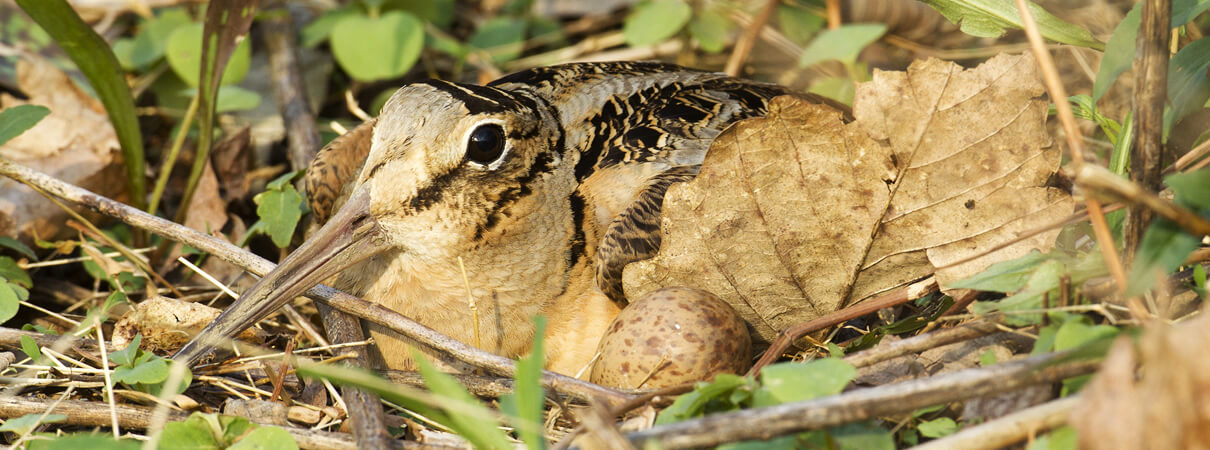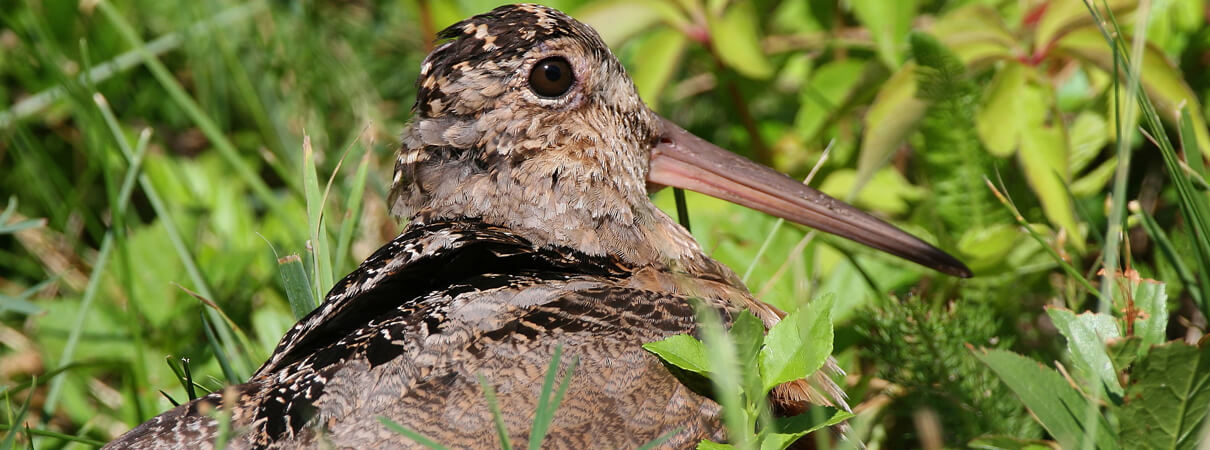In Search of American Woodcock
Beginning tomorrow, Saturday, April 15, I and a team of graduate students and research technicians with Jeff Larkin of the Indiana University of Pennsylvania (IUP) Research Institute will spend many of our evenings out in the field. Our goal is to document a most peculiar ecological phenomenon: the nighttime courtship of the American Woodcock.

The American Woodcock is a creature of overgrown fields and young forests. As these habitats become less common, so too do the birds. David Byron Keener / Shutterstock
As is often the case, Aldo Leopold said it best:
“Knowing the place and the hour, you seat yourself under a bush to the east of the dance floor and wait, watching against the sunset for the woodcock's arrival. He flies in low from some neighboring thicket, alights on the bare moss, and at once begins the overture: a series of queer throaty peents spaced about two seconds apart, and sounding much like the summer call of the nighthawk. Suddenly the peenting ceases and the bird flutters skyward in a series of wide spirals, emitting a musical twitter. Up and up he goes, the spirals steeper and smaller, the twittering louder and louder, until the performer is only a speck in the sky. Then, without warning, he tumbles like a crippled plane, giving voice in a soft liquid warble that a March bluebird might envy”
American Woodcocks: A Shorebird in the Forest
Their dance and song is not all that sets these unusual birds apart. Despite their preference for the shrublands, fallow fields, and young forest communities — those scrubby stands of trees and shrubs that are neither mature forest nor full, open meadow — of eastern North America, American Woodcocks are really shorebirds. They are more closely related to sandpipers than to any of their forest-dwelling neighbors. But, lineage aside, these birds are most definitely creatures of the forest and field. These are the places where woodcocks congregate for courtship, nesting, and brood-rearing every spring.

Female woodcocks rely on their mottled brown feathers and dense, scrubby habitat to camouflage them from predators as they incubate their eggs. Photo by Joe McDonald / Shutterstock
Female woodcocks incubate their nests of four eggs directly on the ground, where they rely upon their earth-colored plumage and dense vegetation to conceal their nests from predators. It is for this reason that the species so heavily relies upon these densely vegetated habitats for breeding. The thick growth of shrubs, grasses, and young trees helps hide the females and their offspring from potential predators.
The birds aren't just difficult for predators to find. They also pose a challenge for would-be researchers. Because the American Woodcock is a solitary, cryptic inhabitant of dense vegetation, we researchers can best study this bird during its courtship displays, which are — as Leopold describes — fairly conspicuous.
Conspicuous though woodcock displays are, seeing and documenting this behavior requires us to visit potential woodcock habitats after sunset because these birds display most comfortably under the cover of dusk.
Less Habitat. Fewer Woodcocks.
For generations, farmland and forest owners have been entertained and inspired by the “sky dance” of spring woodcocks. But, over the years, fewer and fewer of these “dancers” have graced our night skies.
This is why we are studying woodcocks. The species is on the decline, especially throughout the eastern portion of their range. In fact, many other birds that use the same habitat — such as Golden-winged Warblers, Prairie Warblers, and Field Sparrows — are also on the decline. We don't yet fully understand the drivers behind these population losses, but the prime suspect is habitat loss. There is simply less young forest habitat than there used to be.
Fortunately, the loss of this young forest habitat has not gone unnoticed. In fact, researchers have studied the problem, and have written management recommendations to guide habitat management and restoration projects. The ultimate goal of these efforts is to provide more and improved breeding habitat for woodcocks, songbirds, and other young forest-dwelling animals.
A Hopeful Future for American Woodcocks
Many places are already being managed with these guidelines in mind. These are the places where we survey for woodcocks. This spring, we will survey thousands of these managed acres in order to record the occupancy and density of singing American Woodcock across the Appalachian Mountains and Great Lakes. This is our third year of woodcock surveys. Already, in 2015 and 2016, we have documented hundreds of American Woodcocks at sites managed for young forest wildlife. We hope for similar successes this season.

Ongoing population surveys suggest that American Woodcock populations are healthiest where the land is actively managed to support the dense, scrubby habitat the birds prefer. Photo by Betty Rizzotti
So far, our results are promising. While woodcocks are increasingly rare across their full range, there appears to be no shortage of the birds on these managed habitats. This is a positive sign from a conservation perspective — here is proof that our land management efforts are working.
Spring Nights Are Woodcock Nights
The woodcock is an early migrant species, arriving on their breeding grounds well before many other migratory birds. Their song and dance accompanies the early spring choruses of spring peepers, wood frogs, and American toads. Because of this, their courtship display offers both researchers and naturalists alike the opportunity to witness avian behavior well before most warblers, vireos, and other songbirds return to northern states. In fact, many of our IUP crew have already ventured afield to watch the woodcocks preform in advance of our official April 15 start date. The stresses of preparing for our field season grow distant when we watch the enchanting display of the sky dancers.
As Leopold reminds us:
“the drama of the sky dance is enacted nightly on hundreds of farms, the owners of which sigh for entertainment, but harbor the illusion that it is to be sought in theaters… The woodcock is a living refutation of the theory that the utility of a game bird is to serve as a target, or to pose gracefully on a slice of toast. No one would rather hunt woodcock in October than I, but since learning of the sky dance I find myself calling one or two birds enough. I must be sure that, come April, there be no dearth of dancers in the sunset sky.”
Soon, we will head back into the woods on our own “hunt” for woodcocks. This year, for the first time, we will share updates here about our woodcock surveys. Then, when the Golden-winged Warblers return, we will share updates from that field season as well. Stay tuned!
D.J. McNeil is a Ph.D. student at Cornell University. He and other members of the American Woodcock and Golden-winged Warbler field research teams will be sharing stories from the field on ABC's Bird Calls blog throughout the 2017 spring field season.


















































